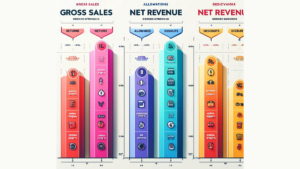This article will explain what contra revenue is, how to record it accurately, and some effective management strategies. We’ll also touch on related topics like gross vs. net profit, prepaid expenses, and unearned revenue.
This guide is also related to our articles on understanding gross vs. net profit, understanding prepaid expenses, and understanding unearned revenue.

- Contra revenue accounting
- Recording sales returns
- Managing sales discounts
- Financial statements impact
- Small business accounting tips
Alright, let’s get started!
Explaining Contra Revenue
Contra revenue refers to the amounts deducted from your gross sales. These deductions, which come in the form of sales returns, allowances, and discounts, are not expenses but adjustments that lower the total sales on your income statement.
Sales returns
Sales returns occur when a customer returns a product they previously purchased, a common occurrence in retail and e-commerce. As a business owner, you’ll record these returns as contra revenue because they reduce the initial sales amount reported.
For example, if you sold a product for $100 and it’s returned, you would record a $100 decrease in your sales revenue.
Allowances
Allowances are slightly different. They happen when you reduce the selling price of an item, typically due to minor defects or because a customer negotiated a lower price after the sale.
This means if you sold an item for $100 but gave a $10 allowance for a small scratch, you’d record $90 in net sales instead of the full $100.
Discounts
Discounts are price reductions given under specific conditions such as early payment, bulk purchases, or during promotional sales events.
If you offer a 5% discount on a $100 item for early payment, you’ll record sales of $95. This encourages prompt payment and can help boost your cash flow.
Make sure to distinguish contra revenue from expenses. Expenses are the costs of operating your business, like rent, salaries, and utilities. Contra revenue, on the other hand, directly reduces the sales figures reported on your financial statements. While both affect your net income, they do so in different parts of your income statement.
Impact on financial statements
In your financial statements, contra revenue accounts appear as deductions from gross sales to arrive at net sales. If your business makes $100,000 in gross sales, say, and has $5,000 in total contra revenues from returns, allowances, and discounts, your net sales would be reported as $95,000.
Make sure you track each type of contra revenue carefully to maintain precise records that can then inform your business decisions and help you spot trends or issues in sales processes, product quality, or pricing strategies.
Recording Contra Revenue
Recording contra revenue accurately in your accounting books is crucial for maintaining reliable financial records. Let’s break down how to do this step-by-step, look at some examples of journal entries, and discuss the best practices for documentation.
Step-by-step guide on how to record contra revenue
- Identify the type of contra revenue: First, determine whether the transaction is a sales return, an allowance, or a discount.
- Create a journal entry: Make a journal entry in your accounting software or ledger as soon as the transaction occurs.
- Debit and credit the appropriate accounts: For sales returns and allowances, debit the Sales Returns and Allowances account and credit the Accounts Receivable or Cash account depending on whether the sale was on credit or paid in cash. For discounts, debit the Sales Discount account and credit the same as above.
- Adjust inventory if needed: If the transaction involves a return, make sure to adjust your inventory to reflect the item coming back into stock.
- Review and reconcile: Regularly review the entries to ensure accuracy and reconcile them with your bank statements and sales reports.
Examples of journal entries
Sales returns: Suppose a customer returns a product they bought for $200. The entry would look like this:
- Debit Sales Returns and Allowances: $200
- Credit Accounts Receivable or Cash: $200
Allowances: If you offer a $50 allowance on a slightly damaged item sold for $500, the entry would be:
- Debit Sales Returns and Allowances: $50
- Credit Accounts Receivable or Cash: $50
Discounts: For a 10% discount given on a $300 sale for early payment, your entry would appear as:
- Debit Sales Discounts: $30
- Credit Accounts Receivable or Cash: $30
Best practices for documentation
- Keep detailed records: Maintain detailed records of all transactions that result in contra revenue. This includes invoices, receipts, credit notes, and correspondence with customers.
- Use clear descriptions: When making journal entries, use clear descriptions that reflect the nature of the transaction. For example, specify whether a discount is for early payment or bulk purchase.
- Organize documentation: Organize your documentation in a way that makes it easy to retrieve for audits or financial analysis. Consider using digital tools for better organization and backup.
- Regular audits: Conduct regular audits of your contra revenue entries to ensure they are accurate and reflect the actual transactions. This can help catch errors or discrepancies early on.
- Train your team: If you have a team handling sales or accounting, train them on how to properly record and document contra revenue to ensure consistency and accuracy across all transactions.
Managing Contra Revenue
Here are some practical ways to lower contra revenue, improve your discount strategies, and make sure your policies match industry standards.
Strategies to reduce contra revenue
- Improve product quality: By improving the quality of your products, you can significantly reduce the number of returns and allowances. Invest in quality control processes and gather feedback from customers to identify areas for improvement.
- Refine return policies: Make your return policies clear but reasonable. Limit the return window to a suitable time frame that allows customers enough time to return products but doesn’t leave your business vulnerable to outdated stock returns.
- Enhance customer satisfaction: Making sure your customers are happy can lead to fewer returns and complaints. Strive for excellent customer service, with prompt responses to inquiries and actively solving customer problems.
Techniques for optimizing discount strategies
Consider offering discounts tailored to different customer segments. For example, you might offer bulk purchase discounts to large buyers but limit early payment discounts to customers who have shown reliability in the past.
You could run discounts for a limited time to create urgency. This can help clear out inventory without making customers accustomed to buying only when there’s a sale.
Regularly analyze the impact of your discounts on overall profitability. Are these incentives genuinely boosting your bottom line or merely shifting the timing of sales?
Review allowance and discount policies periodically
Schedule regular reviews of your allowance and discount policies so they remain competitive and relevant to your market conditions. This might mean adjusting your strategies based on seasonal trends, customer feedback, or new market entrants.
Speaking of which, make sure you keep an eye on your competitors and industry best practices. If your allowances or discounts are out of step with industry norms, you might be either giving away too much or not enough to attract customers.
Base any policy adjustments on data. Analyze sales patterns, customer behavior, and profitability metrics to inform your decisions. You don’t want to make policy changes based purely on intuition or sporadic feedback.
Conclusion
Make sure you actively manage your contra revenue. Regular reviews and adjustments based on comprehensive data analysis can significantly aid in maintaining healthy profit margins.
Look at contra revenue management as a key part of your broader financial strategy. Focusing on these areas can help your business not only survive, but thrive, in today’s competitive market.
Next, check out our articles on bank reconciliation example: step by step, what is a chart of accounts?, and the essentials of business budgeting.

FAQ: Understanding Contra Revenue
Here's some answers to commonly asked questions about Understanding Contra Revenue.
What exactly is contra revenue, and how does it differ from regular expenses?
Contra revenue refers to deductions from your business’s gross sales, including sales returns, allowances, and discounts. Unlike regular expenses such as rent or salaries, which are the costs of operating your business, contra revenue is directly subtracted from sales revenue on your financial statements. This distinction is crucial because it affects how you analyze your business’s revenue performance and profitability.
How should I record a sales return in my accounting books?
To record a sales return, create a journal entry where you debit the Sales Returns and Allowances account and credit the Accounts Receivable or Cash account, depending on whether the original sale was made on credit or with cash. For instance, if a customer returns a product worth $200 that they bought on credit, you would debit Sales Returns and Allowances for $200 and credit Accounts Receivable for $200 to reflect the reduction in revenue due to the returned item.
How can I effectively manage contra revenue in my small business?
To manage contra revenue effectively, focus on strategies that minimize these occurrences and enhance profitability. Improve product quality to reduce returns and allowances. Refine your return policies to be clear yet reasonable, balancing customer flexibility with business protection. Also, optimize your discount strategies by offering them selectively based on customer segment or purchase behavior. Regularly review these policies and adjust based on data-driven insights to align with market conditions and customer expectations.


